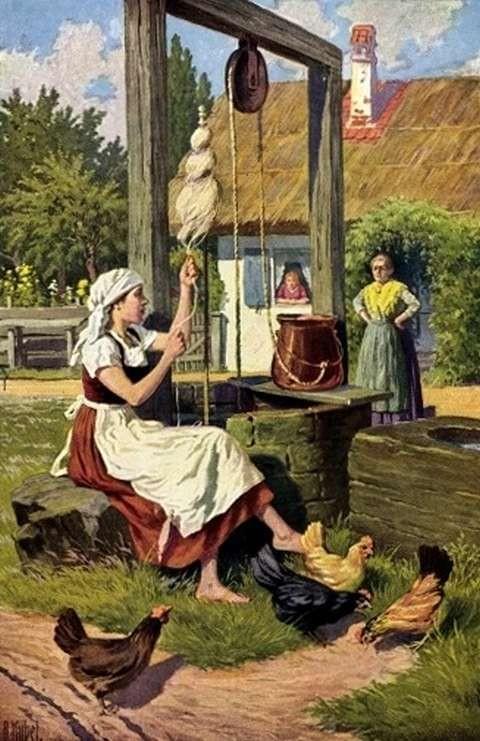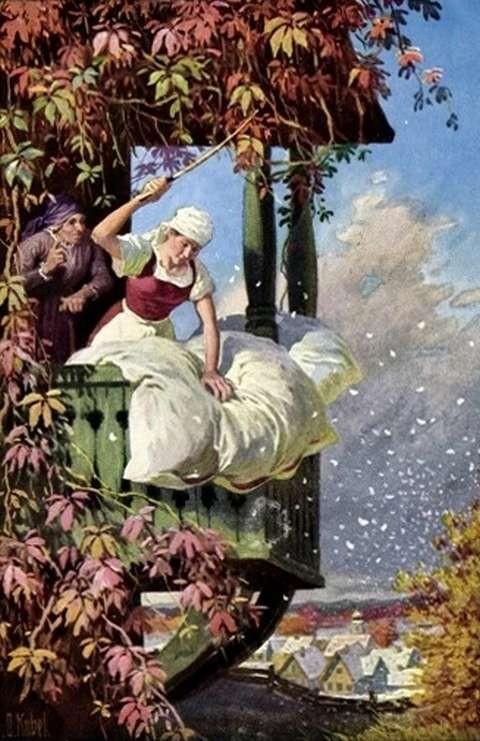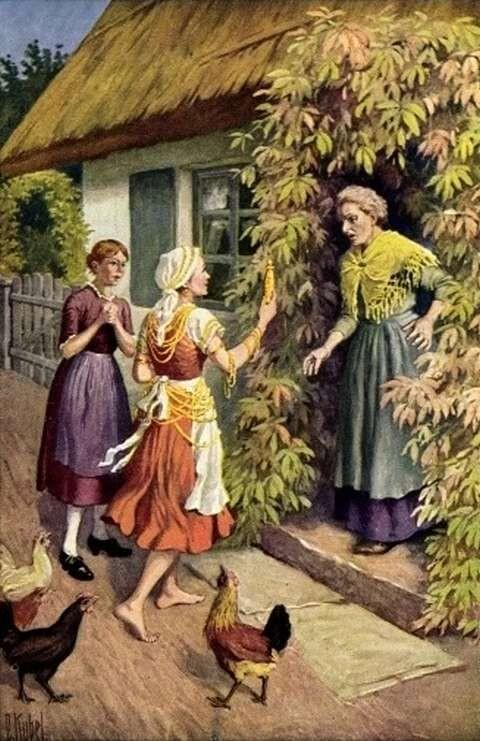Mother Holle is also known under several titles: Mother Hulda, Old Mother Frost, and Frau Holle, to name just a few. Otto Kubel portrayed six scenes from the fairy tale, which were published in a series of six picture cards. We'll summarize the story, present the postcards, and offer a bit of analysis at the end.
Summary
Once upon a time, there was a widow who had a daughter and a stepdaughter. She didn't like her stepdaughter, who had to work hard all day, while her stepsister hardly moved a finger. That's how spoiled she was by her mom.
One day, the stepdaughter was spinning by the well, like many times, until her fingers started bleeding. A spindle became dirty, and she tried to wash it in water, but it fell down the well.

When she returned home, her stepmother was furious and sent her back to get the spindle no matter what. The girl couldn't reach it and jumped into the well. She fainted.
When she woke up, she was in the meadow. There, she soon spotted an oven. The oven was full of freshly baked bread and asked her to unload it. The girl obeyed and continued walking. Then she found a tree full of apples. The tree asked her to shake it, and she did.

Not long after, she found a big house where an old woman lived. The woman was Mother Holle. She invited the girl to stay at her place and work for her. She promised her a reward.
The girl agreed. She worked as hard as she was used to. Her main task was to shake the feather mattress. If feathers came out, somewhere snow fell.

After some time, she became homesick. Mother Holle took her to the gate, where she gave her back her spindle. When the girl stepped out, a cloud of gold dust covered her. This was her reward.

The girl came home and told her story.

Her stepmother was jealous and wanted gold for her daughter as well. She told her to go to the well, prick her finger so some blood would fall in the water, throw the spindle in, and jump after it.
Her daughter did that and came to the same meadow as her stepsister. But she didn't take the bread out of the oven or shake the tree. She managed to work hard at Mother Holle only for the first day and, after some time, hardly got out of her bed.
Mother Holle fired her. She took the girl to the same gate as she took her stepsister. But this time, the reward was different.
The lazy girl became covered with tar.

This tar never came off.
Analysis
While this fairy tale is not among the most popular ones, we can easily recognize many familiar elements:
- The well has an important role. Just like the well in The Frog King, it serves as the place of initiation, the beginning of a new life in a new world. This should not be a surprise because the wells served as an important place for social interactions in the past, and many girls (and boys) met their future spouses right there.
- Spinning has an important role. It's hard and unpleasant work, which can be occasionally dangerous as well, as we learned in Briar Rose or Rumpelstiltskin. It's also a kind of work closely associated with storytelling (it was very time-consuming, and spinning ladies were known as good storytellers) and Mother Holle, who is an Alpine goddess of spinning (among other things).
- Bad stepmother and stepsister against a good girl is the main conflict of the story. We know the same conflict from Cinderella, where hard work and patience are rewarded, and bad behavior is cruelly punished (we are talking about Grimm's version).
To explore even more, you can visit Mother Holle, illustrated by Fritz Kunz, and compare the illustrations by both German artists. Or, you can check the older version of the same story, written by Charles Perrault. It's titled Diamonds and Toads or The Fairies.
If you enjoyed this post, share it with your friends. Thank you!